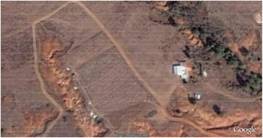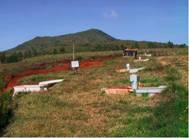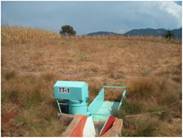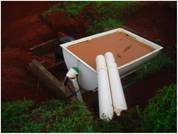Conservation measures and experimental setup
Experimental setup
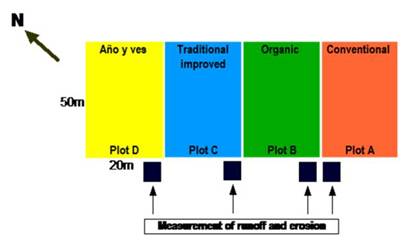
Soil erosion measurement plots
Four plots are delimitated by small earth walls and a H-flume downstream conduct runoff and sediments eroded to "balance-tanks" of 2 000 l capacity. In case of higher runoff volume, a nearly 2% of water quantity is retain in a second tank. Water with sediments was sampled after every event (means nearly every day during rainy season).
These runoff-sampling equipments, based on a Giessen University (Germany) special design developed in Tlalpan (Mexico) for a previous European Commission project, and modified for Atécuaro, making them smaller and therefore easier to manipulate. Runoff measurements were performed with sampling equipment that included both an H-flume water-level recorder and a scaled-container that permits to determine run-off quantity and the sediment weight of runoff after each storm. The advantages of this sampling device are that it might be used to measure runoff carrying a heavy sediment load, to extract a uniform flow percentage at all flow rates, and take samples containing the same particle-size distribution as the total runoff. In fact, soil erosion was really lesser than expected. As the measurement error with this system was higher than the real weight of the eroded sediments, we stop to use the weight and took samples of water after every event.
Plots are under 4 different agronomical treatments based on the traditional crop association of maize+beans+zuquini: Fallow, traditional crop, zero tillage+crop residues, and crop with improved fertility (chemical + crop residus). In year 4 and 5 the improved fertility treatment had been replaced by barley crop. Ploughing direction is normal.
- WOCAT reference conservation measure (Qt reference):
- WOCAT reference implementation approach (Qa reference):
|
Aerial view of the site with plots and tanks (small points in white in the border of the gully) (photo: Google earth 2007) |
Site with plots, H-flume and tanks (photo: C. Prat, 2007) |
Fallow plots, H-flume and tanks (photo: C. Prat, 2007) |
Collector tanks of plot 1 and 2 (photo: C. Prat, 2007) |
|
Collector tank of plot 1 after strong rain event (photo: C. Prat, 2007) |
Tensiometers in plot between corn (photo: C. Prat, 2007) |
Disk infiltrometer in plot 3 (photo: C. Prat, 2008) |
Expected effects
Impact of mulching, reduced soil working and crop residues must increase the soil fertility and so the production of the crop for human and animal uses, infiltration rate (so reduction of runoff and soil erosion) as well on C capture through reduction of compaction, splash erosion and crusting as well increasing of soil life activities.
